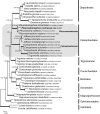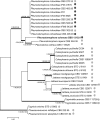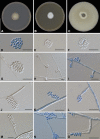Pleurostomophora ochracea, a novel agent of human eumycetoma with yellow grains
- PMID: 22760037
- PMCID: PMC3421786
- DOI: 10.1128/JCM.01470-12
Pleurostomophora ochracea, a novel agent of human eumycetoma with yellow grains
Abstract
The first yellow-grain fungal mycetoma, in a 60-year-old man from Central Sudan, is reported. Morphological and phylogenetic analysis of the ribosomal small subunit (SSU), large subunit (LSU), internal transcribed spacer (ITS), β-tubulin (BT2), actin (ACT1), and elongation factor (TEF1) genes revealed that the isolate deviated from any known agent of mycetoma; it clustered in the genus Pleurostoma (anamorph genus, Pleurostomophora) in the order Calosphaeriales. The novel species, here named Pleurostomophora ochracea, is characterized by phenotypic features. The species proved to be highly susceptible to itraconazole, ketoconazole, posaconazole, and voriconazole, but not to fluconazole. The fungus was inhibited by caspofungin at 8 μg/ml, while no inhibition was found with 5-flucytosine (MIC > 64 μg/ml). Compared to other members of the genus Pleurostomophora, P. ochracea is slow growing, with a relatively high optimum growth temperature (36 to 37°C). This is the first case of a yellow-grain fungal mycetoma; yellow grains are otherwise of bacterial nature. Our case emphasizes that identification of mycetoma agents by the color of the grain only is not sufficient and may lead to inappropriate therapy.
Figures





References
-
- Ahmed A, et al. 2007. Management of mycetoma: major challenge in tropical mycoses with limited international recognition. Curr. Opin. Infect. Dis. 20:146–151 - PubMed
-
- Ahmed AO, et al. 2004. In vitro susceptibilities of Madurella mycetomatis to itraconazole and amphotericin B assessed by a modified NCCLS method and a viability-based 2,3-bis(2-methoxy-4-nitro-5-sulfophenyl)-5-[(phenylamino)carbonyl]-2H-tetrazolium hydroxide (XTT) assay. Antimicrob. Agents Chemother. 48:2742–2746 - PMC - PubMed
-
- Ahmed AO, et al. 2004. Mycetoma caused by Madurella mycetomatis: a neglected infectious burden. Lancet Infect. Dis. 4:566–574 - PubMed
Publication types
MeSH terms
Substances
Associated data
- Actions
- Actions
- Actions
- Actions
- Actions
- Actions
LinkOut - more resources
Full Text Sources
Other Literature Sources
Molecular Biology Databases

